In this article, you’ll discover the following:
- User-generated content (UGC) builds trust, loyalty, and social proof by showcasing real customers using your products which increases engagement and repeat purchases.
- Voice search optimization is essential, with conversational, full-question formats and schema markup becoming necessary as smart speaker usage for shopping grows.
- AR/VR implementation bridges online and offline, allowing customers to visualize products in their environment or explore items in 3D before buying.
- Zero-party data collection empowers personalization, using quizzes, surveys, and account info to gather voluntary customer insights in a privacy-first world.
- Sustainability-centric branding resonates, as consumers increasingly reward transparent eco-friendly practices and are willing to pay more for sustainable products.
Ecommerce marketing includes a plethora of tactics and tools designed to help retail businesses build awareness, drive site traffic, and increase conversions.
Email newsletters, social media, SEO, paid ads, blog posts, even the copy on your website… They can all be effective methods for achieving your specific web commerce marketing objectives, when used strategically of course!
However, the tricky part is that what’s thought to be a stellar marketing technique one day may turn out to be a dud the next. Online retailers like yourself must constantly keep an eye on current industry data, consumer preferences, and emerging global trends and be ready to react accordingly to be able to market their offerings in the best way possible.
With the growth of ecommerce, consumers now have many more choices regarding where to buy products than they did even just a short while ago. Learning about the current trends, insights, and direction concerning ecommerce marketing is essential to helping your business experience more growth and (hopefully) earning more revenue.
In this article, we’ll take a look at some of the top ecommerce marketing trends dominating online sales on a global level today and that may very well continue to be helpful strategies in the future of ecommerce!
Table of contents
- 1. User-generated content as a core strategy
- 2. Voice search optimization
- 3. Consistency with omnichannel marketing
- 4. Mobile experience optimization
- 5. AR and VR implementation
- 6. Micro-influencer collaboration
- 7. Shoppable livestreams
- 8. Artificial intelligence for various uses
- 9. Zero-party data collection
- 10. Sustainability-centric branding
- 11. Localized and hyper-personalized marketing
- 12. Retargeting ad campaigns
- 13. Use of videos
- Do you need to follow all of these ecommerce marketing trends?
1. User-generated content as a core strategy
User-generated content (UGC) is one of the most powerful tools ecommerce businesses have at their disposal today. This is content about a brand that’s created by people using the brand’s products or services rather than produced by the brand itself.
When shoppers are evaluating whether to make a purchase from an online shop that’s new to them, they want to be sure that it’s a trustworthy retail business.
While the internet commerce company can make all the claims they want boasting their trustworthiness and high-quality products, these messages are going to be much more believable to shoppers if they’re originating from other consumers like themselves.
Well-crafted UGC in the form of videos, images, reviews, etc. is great not just for building trust but for also increasing engagement and loyalty. Users who see their posts shared by their favorite brands feel appreciated and are more likely to return for future purchases.
What’s more, obtaining UGC is generally quite easy!
Here are a few strategies to gather UGC from shoppers:
- Create a branded hashtag and encourage your followers on social media to share posts featuring your products.
- Host a giveaway that involves users snapping their most creative pics or filming videos with your online shop’s offerings.
- Offer customers a discount for their next purchase in exchange for feedback on their most recent order.
Sézane obtaining UGC with a branded hashtag and giveaway
2. Voice search optimization
As consumers increasingly use voice assistants like Siri, Alexa, and Google Assistant to shop, voice search optimization is becoming essential.
Recent data shows that approximately 20.5% of people using voice search around the world and 38.8 million people in the US alone already rely on smart speakers for shopping activities.
Unlike traditional typed queries, voice searches are conversational and often posed as full questions. For instance, a shopper may say “What’s the best sustainable laundry detergent near me?” rather than “sustainable laundry detergent.”
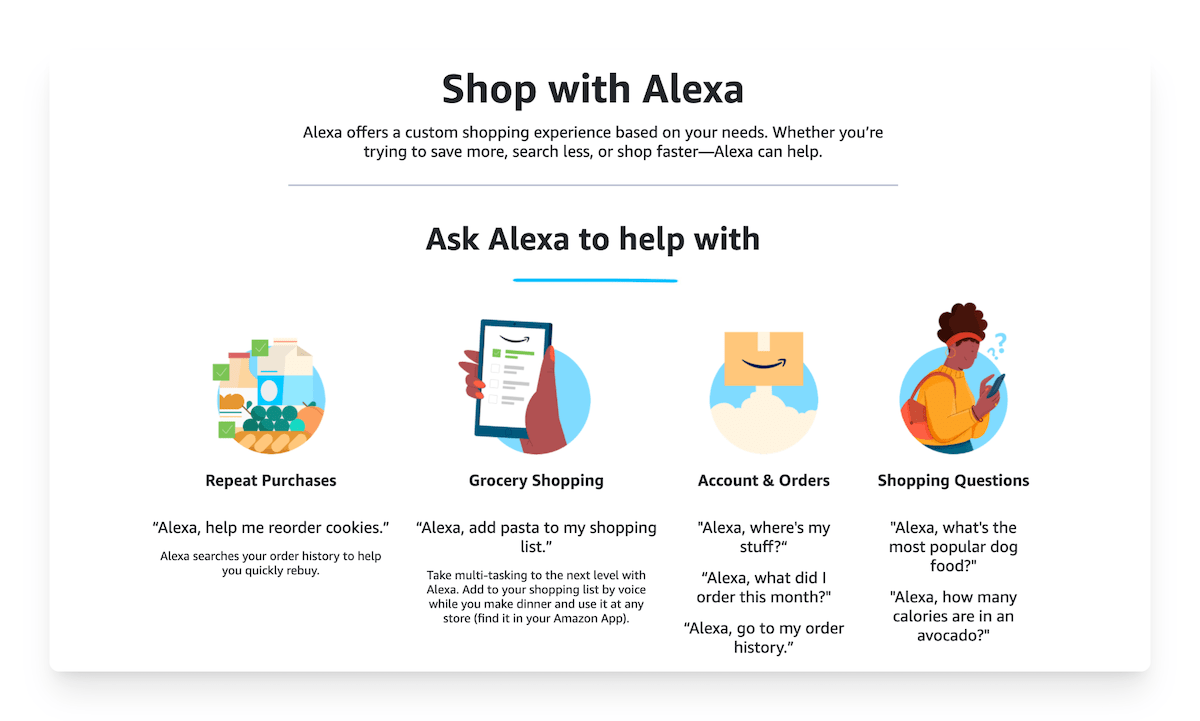
Different ways to shop with Amazon’s Alexa
To maximize success with this trend, online retailers should craft content in a natural, spoken tone, use long-tail question-based keywords, structure FAQ pages effectively, and implement schema markup to help search engines and voice assistants understand answers.
3. Consistency with omnichannel marketing
In recent years, global consumers have been found to increasingly encounter a brand via numerous touchpoints when they want to buy a product.
For instance, they might head to the company’s ecommerce site from a desktop or mobile device for initial product research, call their customer service number to ask a question, visit their social media pages, return to the website to complete a payment, and finally go to their brick-and-mortar store to pick up an order.

Vacuum cleaners that can be purchased on Best Buy’s website and picked up at local stores
With this in mind, many companies are now availing of omnichannel marketing to ensure a seamless experience for their customers across these different touchpoints.
With omnichannel marketing, brands aim to meet consumers wherever they are in their buying journey. They accomplish this by providing a brand tone and a vision that are consistent and recognizable as well as tailored messaging based on a shopper’s previous interactions and particular interests and preferences.
Note that even if you don’t have a physical store, omnichannel marketing can still be a really effective way to help improve your customers’ experiences with your ecommerce business. In fact, there are all kinds of digital commerce marketing strategies to consider for your omnichannel marketing efforts:
- content marketing,
- email marketing,
- pay-per-click advertising,
- search engine optimization,
- social media advertising, and
- social media marketing.
With effective omnichannel marketing, you’ll be able to increase the number of opportunities for shoppers to locate and interact with your brand on the internet. Rather than just creating a single path to conversion and payment, you’ll give your customers a multitude of options, allowing them to select what works best for them.
4. Mobile experience optimization
In today’s world, whether you’re riding the subway, sitting in a coffee shop, or waiting at the dentist’s office, it can be difficult to spot somebody who doesn’t have a cell phone in hand. People are using their mobile devices for an increasing number of activities, including shopping.
Ecommerce companies are taking note of the growing importance of mobile commerce (m-commerce) when it comes to their revenue and optimizing their sites for customers who prefer purchasing goods from a mobile device.
While optimizing for the mobile experience isn’t a new trend in ecommerce, it’s quickly becoming an essential step rather than an optional one in a well-planned internet commerce marketing strategy.
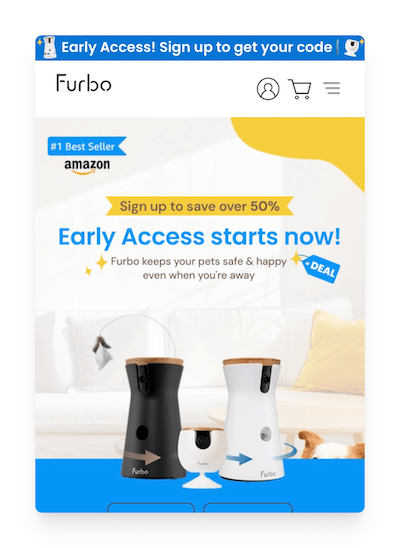
Furbo’s mobile site design, allowing for easy shopping
In reality, many consumers nowadays expect to be able to complete their purchases from a mobile device. If you don’t provide a pleasant mobile experience, your visitors may quickly decide to head to your competitor’s website instead!
To ensure that your ecommerce site is optimized for mobile use, there are several actions you can take.
You can begin by integrating responsive design into your online store. This will allow your site to conform to whatever device a shopper is using.
Other ways to improve the mobile experience include adding buttons that are easy for thumbs to press, phone-friendly payment solutions, and offering a super simple mobile checkout process.
5. AR and VR implementation
Augmented reality (AR) and virtual reality (VR) are valuable tools for ecommerce marketers because they aid in making the customer experience more interactive and engaging.
While they don’t completely replace being able to see or touch a product in person, they make it possible for site visitors to better visualize the item in question and imagine using it for themselves. In short, they help to bridge the gap between online and offline shopping.
Although the terms AR and VR are sometimes used interchangeably, they provide consumers with different experiences.
Ecommerce stores availing of AR put a virtual product in a real-world environment, e.g., a furniture store that allows people to see how a particular coffee table might look in their living room.
It can also give people the opportunity to “try on” items, such as makeup or clothing.

Trying on frames with the Warby Parker app
In contrast, VR places products in a virtual environment, e.g., product pages that offer 360-degree views of the item.
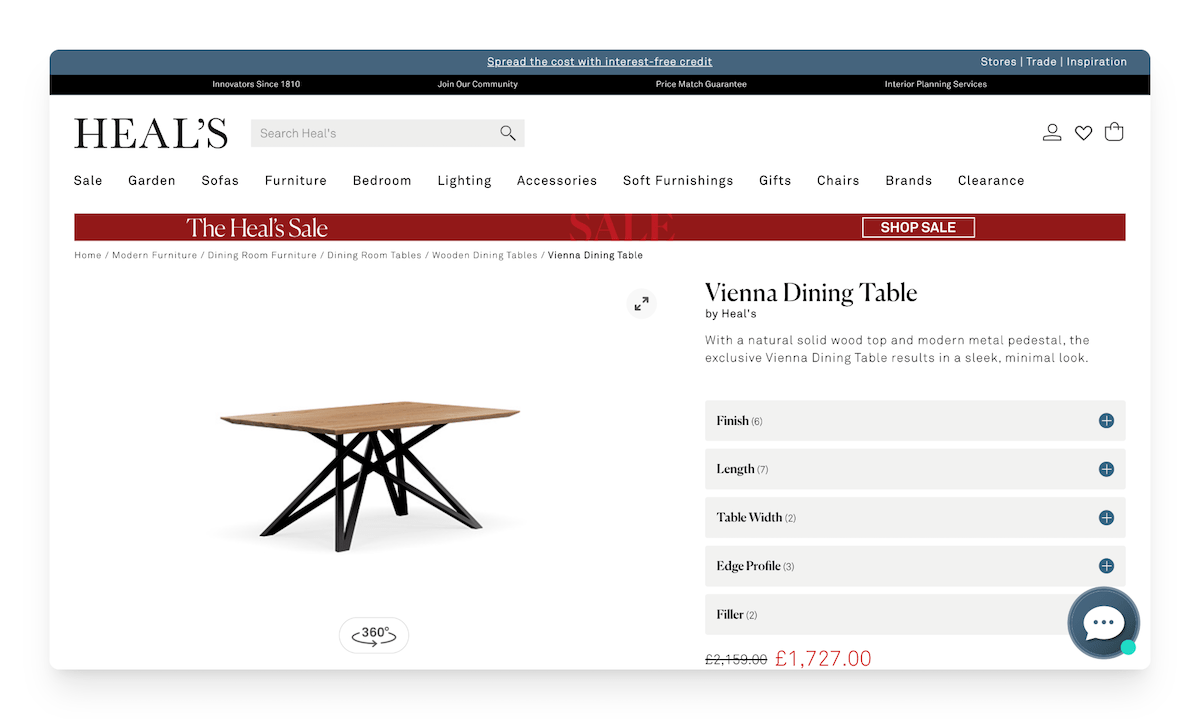
360° product view on the Heal’s website
Although using AR and VR is a hot trend in ecommerce today and will likely continue to see significant growth, it’s not for everybody. Some businesses will benefit from using these types of technologies more than other businesses.
The brands best suited for implementing AR and VR in their marketing strategies are those that sell products where appearance and/or size are important determinants for shoppers regarding their purchasing decisions.
6. Micro-influencer collaboration
Ecommerce companies just entering the market can often find that it’s difficult to grow their audiences on social networks and make people aware of their blossoming new venture in the retail industry.
For this reason, many of them opt to take advantage of influencer marketing, which involves working with somebody who has a large following on social networks, a blog, etc. In exchange for payment and/or free goods, this person will promote a product or service on their platform, allowing the brand to expand their reach significantly.
Influencer marketing continues to be a popular strategy with ecommerce marketers for a variety of reasons, with one of the most significant being that it generally provides a great return on investment (ROI). According to Influencer Marketing Hub, businesses earn an estimated ROI of $6.50 per $1 they spend on influencer marketing!
It’s easy to see why influencer marketing in general is attractive to brands, but there’s now an emerging trend that involves collaborating with micro-influencers.
A micro-influencer is somebody with a social media audience that’s larger than what a regular person would normally have but smaller than those of other more lucrative tiers, say for celebrities or macro-influencers.
The exact number of followers a micro-influencer will have can vary, but it’s usually between 10,000 and 50,000.
Rob Perez (@r.oh.bee) promoting Merrell shoes for trail running
A big advantage of working with micro-influencers is that although they have a smaller number of followers, their community will likely be much more closely knit.
This means that if you collaborate with a micro-influencer in your specific niche, there’s a better chance that the influencer will be promoting your products to an audience of people who will want to purchase those items.
7. Shoppable livestreams
As ecommerce growth continues and the number of online stores increases, web retailers must look for ways to connect with and engage their audiences in order to stand out from the competition.
One strategy that’s recently seen a boost in popularity is the offering of shoppable livestreams, where shoppers can buy products during a live video and interact with the host through comments and reaction buttons.
Shoppable livestream with Hobbii
The live commerce trend is often found on social media platforms like Facebook, Instagram, TikTok, or YouTube, but there are also platforms around that are specifically dedicated to providing retailers with a hosting space for live shopping.
Wherever a brand chooses to hold a shoppable livestream event, the benefits are numerous:
- Increases brand differentiation: Though offering shoppable livestreams is a growing trend, it’s not something you’ll see being done by every company out there. By adopting this tactic into your marketing plan, you’ll be able to differentiate your brand from your competitors, as you’ll be providing an innovative shopping experience.
- Has the FOMO effect: People attending your live shopping event know that the event will only last a few hours at most. This combined with a limited number of products can add to the pressure to make a purchase ASAP, especially if they see others buying up your offerings in the meantime. They won’t want to miss out on the action!
- Boosts brand loyalty: Shoppable livestreams are great for audience engagement. The more connected your followers feel with your brand, the more likely they are to continue to purchase from your online store in the future and tell their friends and family about you.
8. Artificial intelligence for various uses
Although artificial intelligence (AI) has been around for a while, recent advancements over the years have led to the increasing use of this type of technology in web sales, making it one of the fastest growing ecommerce marketing trends of today.
E-merchants are using AI to not just perform a variety of tasks that were previously done manually but also to
improve the customer experience and obtain helpful data for better informed decision making concerning their business.
Here are three ways to use AI for your own ecommerce marketing strategy:
Chatbots and virtual assistants
Online shopping provides both consumers and e-tailers with a plethora of advantages over traditional commerce involving brick-and-mortar stores.
One disadvantage of ecommerce, though, is that shoppers don’t have the physical presence of an employee or assistant to answer questions and help guide them in their purchasing decisions.
In the past, this would often lead to frustration on the visitor’s end, ending with them simply exiting the site if they couldn’t find what they were looking for after a while.
However, developments in AI have brought about the creation of technologically advanced chatbots and virtual assistants that are now able to provide customers with immediate assistance and support at any hour of the day.

Chatbot on the Farmacy Beauty site
With technology involving natural language processing (NLP), these chatbots and virtual assistants can supply shoppers with personalized responses, recommendations, and offers. In addition, the more frequently this AI is used, the more adept it will become at answering users’ queries.
Personalization
Another way to take advantage of AI technology for your ecommerce marketing is by using it to provide your customers with personalized advertising and product recommendations.
How does this work?
After analyzing large amounts of data and obtaining valuable insights concerning shopper behavior, AI algorithms are able to more accurately estimate their needs and preferences.
For example, using a consumer’s shopping history, the AI can suggest items relevant to the consumer’s current search.
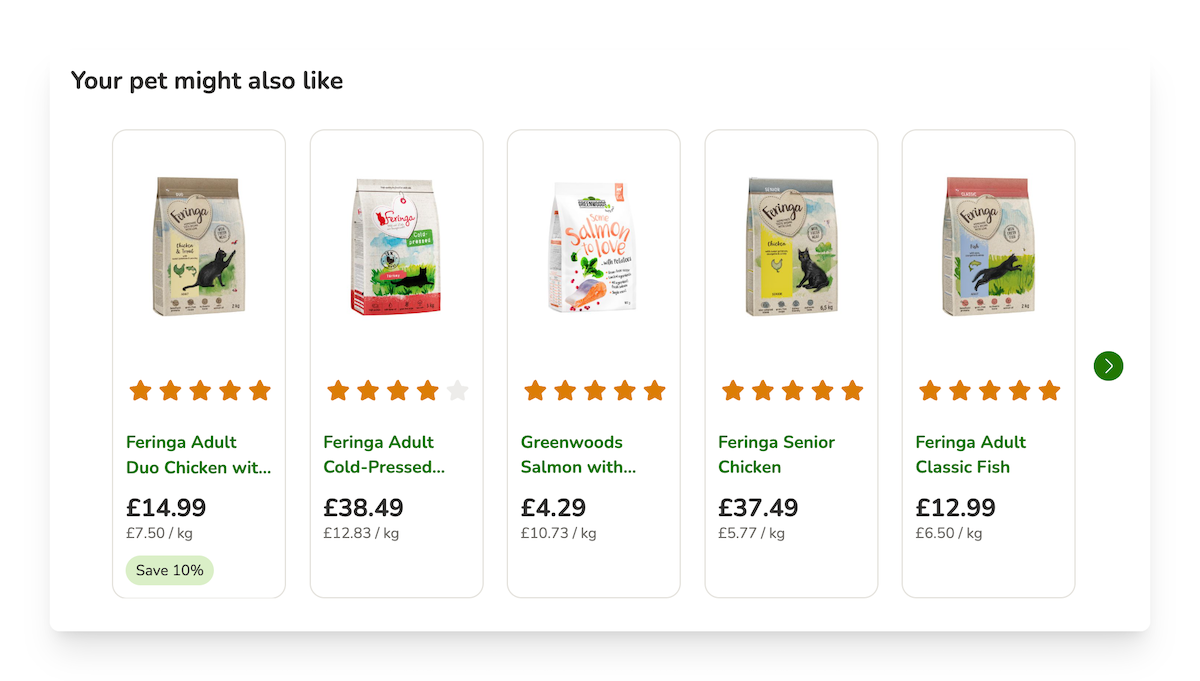
Zooplus product recommendations
When applied strategically, AI insights can assist in making the shopping experience much more enjoyable for customers, leading to better customer retention and increased sales.
AI text generation
Finally, AI is also able to facilitate the writing of all kinds of different texts for ecommerce entrepreneurs to market their products and services..
Copywriting is a crucial task for succeeding in selling online, but for many people, it’s a rather time-consuming process that they dread beginning. Fortunately, today’s AI can help simplify this activity for companies around the world.
The WiziShop ecommerce solution is well aware of the importance of such technology and has created a revolutionary AI copywriting tool designed to help digital commerce retailers like you create numerous kinds of texts: product descriptions, homepage text, blog posts, translations, etc.
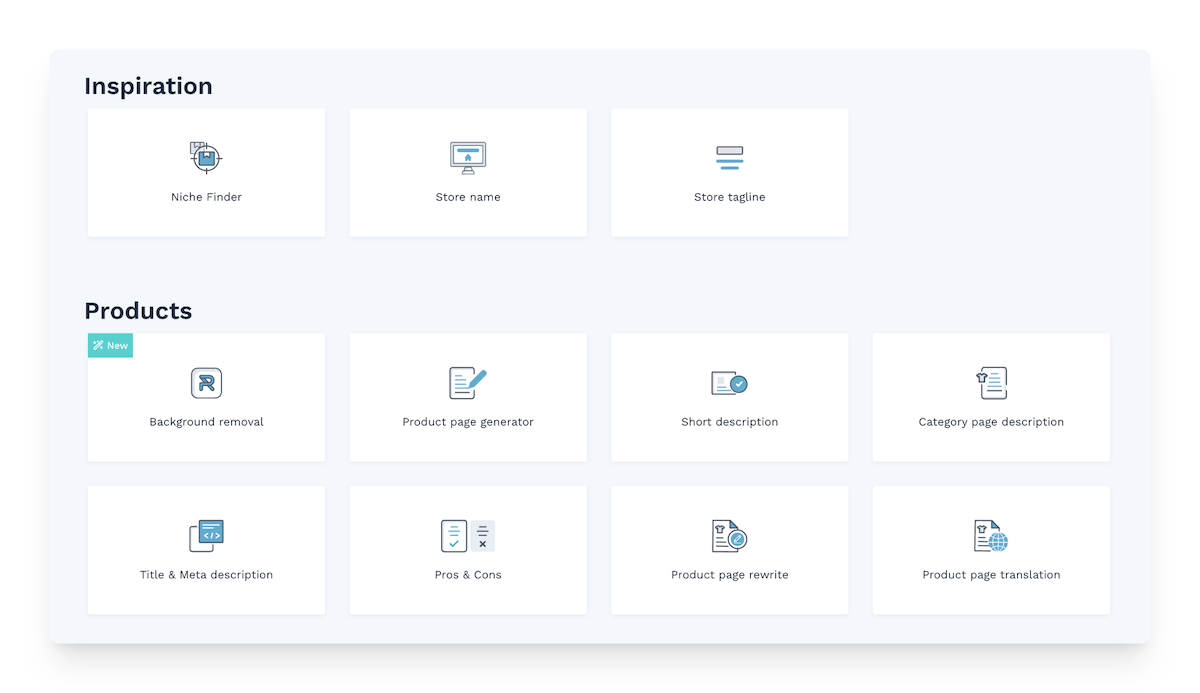
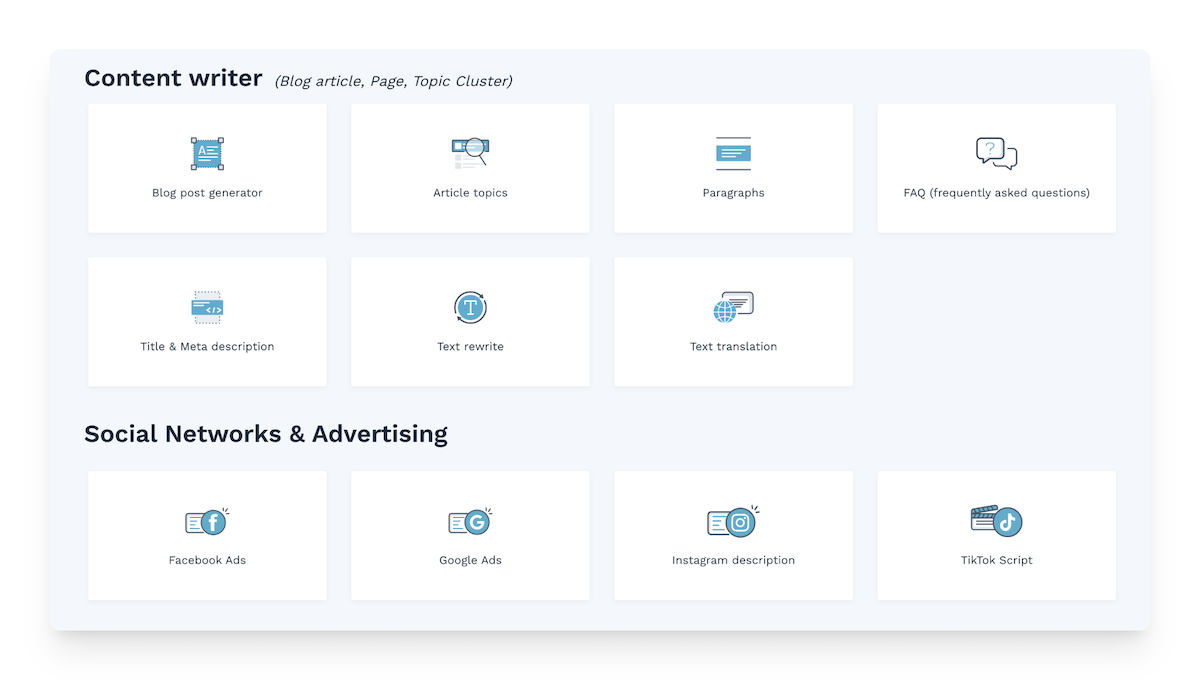
AI text generation offered by WiziShop
This feature can save you loads of time in generating content for your online store, allowing you to focus on other aspects of running your ecommerce business.
Ready to take advantage of this helpful tool?
Sign up with WiziShop and enjoy a 7-day free trial!
Try WiziShop free for 7 days
THE EASIEST NO-CODE ECOMMERCE SOLUTION✅ No credit card required
✅ Access to all features
✅ No commitment
9. Zero-party data collection
With the growth of privacy concerns on a global level and cookie deprecation, businesses are going to rely more on data that customers willingly provide to be able to power marketing personalization for improved shopping experiences.
Zero-party data, which refers to information customers voluntarily share, such as preferences, interests, and intent, is typically collected through quizzes, surveys, account settings, and interactive experiences. It differs from third-party data, as it tends to be more accurate, is based on user permission, and builds trust.
As privacy regulations tighten, digital commerce retailers must adapt by offering engaging, value-driven ways for customers to share their data.
For example, a beauty retailer might use a skincare quiz to recommend personalized products while gathering data on skin type and concerns. Loyalty programs, early-access perks, and personalized experiences are also great incentives.
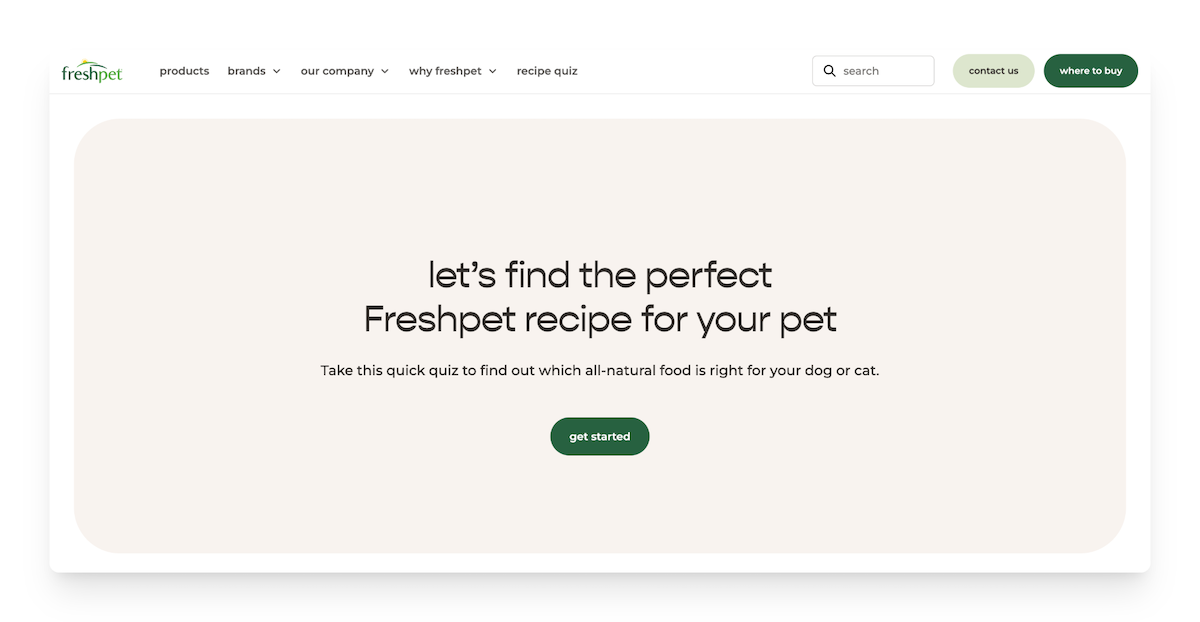
Freshpet product quiz, with results received once the user provides email address
As an ecommerce entrepreneur, it’s advantageous to avail of robust data platforms to manage and activate this consumer-provided data across marketing channels.
When used effectively, zero-party data can create hyper-personalized campaigns, reduce ad spend waste, and build stronger relationships—driving conversions and long-term customer loyalty in a privacy-first world.
10. Sustainability-centric branding
Eco-conscious consumers are demanding transparency, increasingly rewarding digital commerce brands that genuinely prioritize eco-friendly practices.
Effective sustainability branding means showcasing real efforts—from responsibly sourced materials and recyclable packaging to supply-chain transparency and verified impact—rather than making vague “green” claims. This builds deeper trust and long-term loyalty.
A recent PwC survey found customers are willing to pay an average of 9.7% more for sustainably made goods—even during inflationary periods.
Meanwhile, Blue Yonder reports that 78% of consumers rate sustainability as a significant factor in their purchasing decisions.
These figures highlight customers’ strong willingness to support brands with credible environmental commitments as well as a readiness to back it up with their wallets.
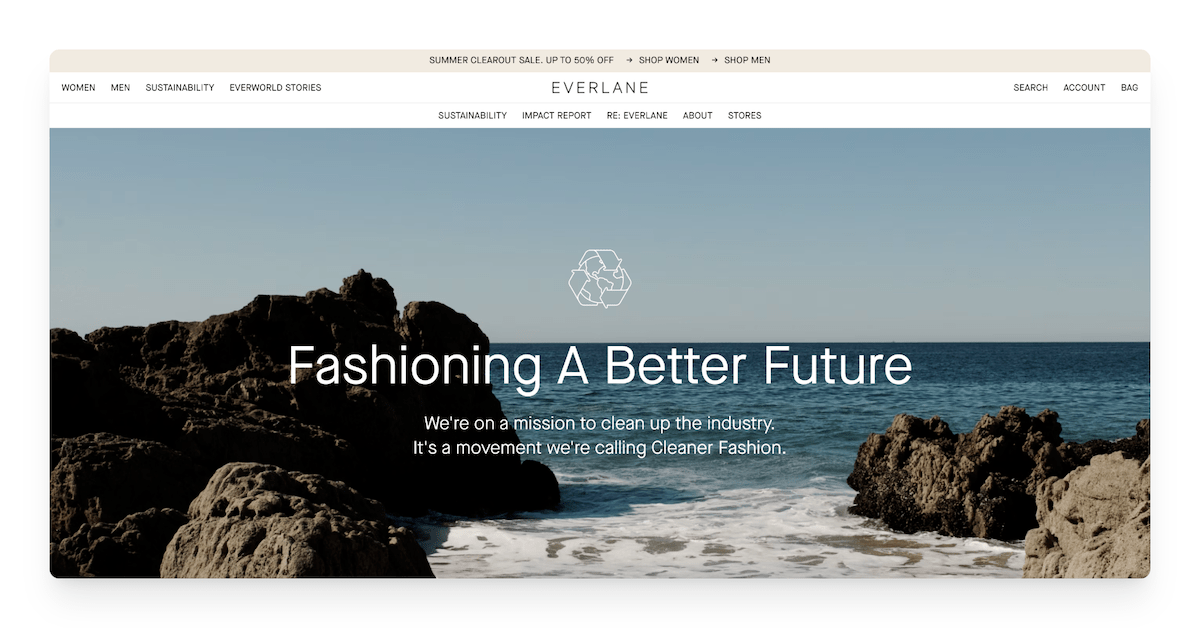
Everlane detailing their sustainability efforts
Web commerce brands that integrate authentic sustainability into their messaging, not just in marketing slogans, but in actual practices, can differentiate themselves, justify premium pricing, and connect emotionally with eco-conscious shoppers.
11. Localized and hyper-personalized marketing
In recent years, a growing number of consumers have come to expect content, offers, and experiences tailored to their specific location, preferences, and behavior.
This trend goes beyond using a customer’s name in an email… It involves delivering targeted messaging based on local weather, events, culture, or even regional slang.
Say that you’re in the fashion market and have an apparel brand. You might promote raincoats to customers in rainy regions while offering summer deals to those shopping in warmer climates.
Hyper-personalization in web commerce also includes using real-time data—like browsing history or cart behavior—to trigger relevant emails, SMS, or app notifications.
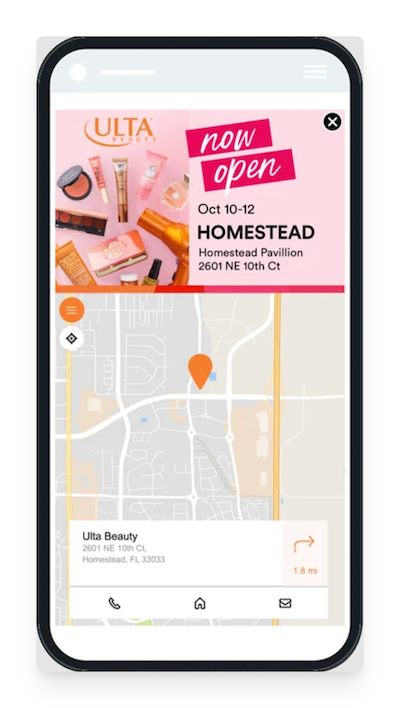
Ulta Beauty geotargeting
To make the most of this trend, e-tailers should invest in advanced customer data platforms (CDPs), geolocation tools, and AI-driven personalization engines.
When executed well, localized and hyper-personalized marketing improves engagement, increases conversions, and builds stronger, more loyal customer relationships.
12. Retargeting ad campaigns
Sometimes people won’t be quite ready to click “Buy now” the first time that they visit your ecommerce website. Perhaps they want to do a bit more research on the product in question to see if it’s right for them or shop around to see if they can find the item at a better price elsewhere.
There are numerous reasons why consumers may leave a site without making a purchase, but it doesn’t mean that they can’t be convinced in the future!
This is where retargeting ads come in.
Retargeting ads are display ads that appear to internet users on other websites after they’ve visited your online store. This kind of paid advertising can be a powerful marketing tool, as it allows you to display your products to potential customers who have already shown an interest in what you’re selling.

Retargeting advertising by Linennaive on Instagram
A simple reminder in the form of a retargeting ad may be just what the shopper needs to decide to return to your website and finally complete a purchase.
Another reason why the use of retargeting ads is one of top ecommerce marketing trends is that while retargeting is helpful to getting visitors to come back to your site, it can also aid in increasing awareness about your brand.
The more frequently a consumer sees your ad or logo, the more likely they are to remember your retail business and what you sell.
To create the greatest impact with your retargeting efforts, be sure to include high-quality visuals in your ads. In addition, don’t forget to add a clear CTA so viewers know what step to take next.
13. Use of videos
Video is rapidly transforming digital commerce, moving from a nice-to-have into a core driver of sales and engagement.
According to Bazaarvoice, the global video commerce market is forecast to grow from $695 billion in 2023 to $3.7 trillion by 2029.
Videos keep shoppers engaged longer—you can triple time on site—and boost conversions dramatically. In fact, embedding video on product pages can increase conversion rates by up to 80%.
Wondering how to incorporate videos into your selling strategy? Here a few ideas to inspire you:
- Use shoppable videos (e.g., in-page clips or livestreams) to let customers buy directly from the interaction. These formats have been shown to boost sales 3 to 5 times over traditional methods.
- Embrace both short-form (Reels, TikToks) for discovery and long-form (demos, tutorials) for decision-making.
- Distribute video across platforms—social media, email, landing pages, and product listings—to create a cohesive, full-funnel experience.
@lego Listen up \ud83d\udce3 #LEGO #Cats #TuxedoCat \u266c Chill Vibes - Febri Handika
Source: LEGO
Do you need to follow all of these ecommerce marketing trends?
In this article’s list of marketing trends that are quickly gaining traction in the world of online sales, there’s a good chance that some of them resonated with you more than others.
Depending on your resources and target market, you may not necessarily be able to or need to apply all of these trends to your own web commerce marketing strategy.
Nevertheless, it’s certainly important to at least be aware of what’s going on in the industry and strongly consider the current ecommerce trends and how to best market your offerings to your ideal customer.
In this digital age, things can change very quickly. Keeping yourself up to date with the latest happenings, technology, and consumer preferences can help you determine how to offer your products and services in order to appeal to customers and stay ahead of the competition.
In any case, remember to remain flexible when it comes to your internet commerce business. Accepting that change is unavoidable and being adaptable to your audience’s needs can go a long way in increasing your chances of success in the long run!










